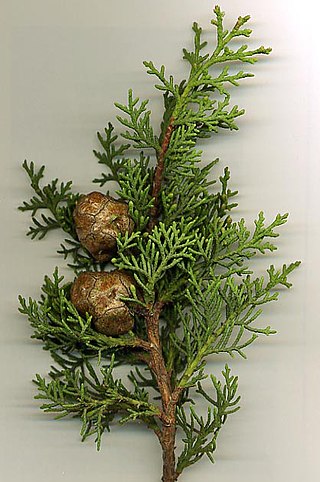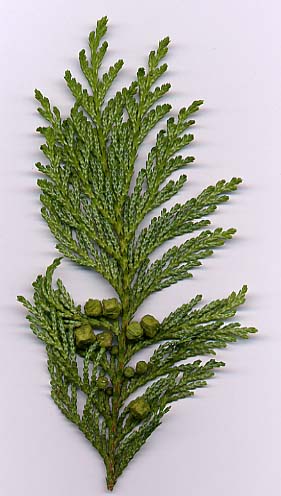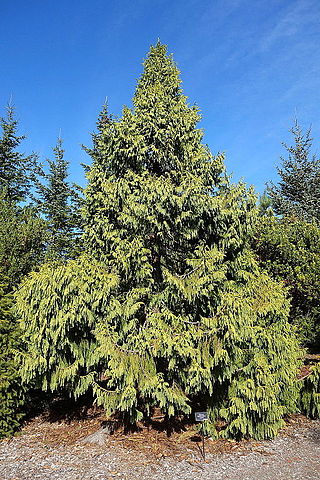Cypress is a common name for various coniferous trees or shrubs of northern temperate regions that belong to the family Cupressaceae. The word cypress is derived from Old French cipres, which was imported from Latin cypressus, the latinisation of the Greek κυπάρισσος (kyparissos). Cypress trees are a large classification of conifers, encompassing the trees and shrubs from the cypress family (Cupressaceae) and many others with the word cypress in their common name. Many cypress trees have needle-like, evergreen foliage and acorn-like seed cones.

Cupressaceae is a conifer family, the cypress, with worldwide distribution. The family includes 27–30 genera, which include the junipers and redwoods, with about 130–140 species in total. They are monoecious, subdioecious or (rarely) dioecious trees and shrubs up to 116 m (381 ft) tall. The bark of mature trees is commonly orange- to red-brown and of stringy texture, often flaking or peeling in vertical strips, but smooth, scaly or hard and square-cracked in some species.

Chamaecyparis, common names cypress or false cypress, is a genus of conifers in the cypress family Cupressaceae, native to eastern Asia and to the western and eastern margins of the United States. The name is derived from the Greek khamai (χαμαί), meaning "on the earth", and kuparissos (κυπάρισσος) for "cypress".

Taiwania, with the single living species Taiwania cryptomerioides, is a large coniferous tree in the cypress family Cupressaceae.

Cunninghamia is a genus of one or two living species of evergreen coniferous trees in the cypress family Cupressaceae. They are native to China, northern Vietnam and Laos, and perhaps also Cambodia. They may reach 50 m (160 ft) in height. In vernacular use, it is most often known as Cunninghamia, but is also sometimes called "China-fir". The genus name Cunninghamia honours Dr. James Cunningham, a British doctor who introduced this species into cultivation in 1702 and botanist Allan Cunningham.

The Formosan clouded leopard is a clouded leopard population that was endemic to Taiwan. Camera trapping studies carried out in several protected areas in Taiwan between 1997 and 2012 did not record any clouded leopard. The population is listed as extinct on the IUCN Red List.

Xanthocyparis is a genus of cypresses in the family Cupressaceae. As of August 2021, it has only one species, Xanthocyparis vietnamensis, native to Vietnam and southeast China. It is commonly known as the Vietnamese golden cypress. The Nootka cypress, Cupressus nootkatensis or Callitropsis nootkatensis, was also placed in the genus, but this has been rejected.
Thuja sutchuenensis, the Sichuan thuja, is a species of Thuja, an evergreen coniferous tree in the cypress family Cupressaceae. It is native to China, where it is an endangered local endemic in Chengkou County, on the southern slope of the Daba Mountains.

The Taiwan field mouse, also called Formosan wood mouse, is a species of rodent in the family Muridae. It is found only in Taiwan.
Juniperus convallium is a species of conifer in the family Cupressaceae. It is a tree that is found only in the mountains of the Chinese provinces of Tibet, Qinghai, and Sichuan.

Juniperus formosana, the Formosan juniper, is a species of conifer in the family Cupressaceae. It is a shrub or tree to 15 metres tall, found in China and in Taiwan.
Juniperus komarovii is a species of conifer in the family Cupressaceae. It is found only in China.

Pinus taiwanensis, the Taiwan red pine, is a species of conifer in the family Pinaceae endemic to Taiwan.

The Indian giant flying squirrel, also called the large brown flying squirrel or the common giant flying squirrel, is a species of rodent in the family Sciuridae. It is capable of gliding flight using a skin membrane stretched between front and hind legs. It is found in mainland Southeast and South Asia, and southern and central China.

Chamaecyparis taiwanensis is a species of cypress, native to the mountains of Taiwan, where it grows at altitudes of 1300–2800 m.

Sequoioideae, commonly referred to as redwoods, is a subfamily of coniferous trees within the family Cupressaceae. It includes the largest and tallest trees in the world. The subfamily achieved its maximum diversity during the Jurassic and Cretaceous periods.

Cunninghamia lanceolata is a species of tree in the cypress family, Cupressaceae. It is native to south-central and southeast China. Ornamentally C. lanceolata is commonly planted as a specimen tree in temperate zones.

Antrodia cinnamomea is a fungus species described as new to science in 1995. It causes brown heart rot of the aromatic tree Cinnamomum kanehirae. It is used in Taiwanese traditional medicine as a supposed remedy for cancer, hypertension, and hangover. The annual market is worth over $100 million (US) in Taiwan alone. The 32.15 Mb genome containing 9,254 genes has been sequenced.

Titania's woolly bat is a species of bat found in Southeast Asia.

Schima superba is a species of flowering plant in the tea family Theaceae, native to subtropical areas of Vietnam, southern China, Hainan, Taiwan, and the Ryukyu Islands. With Pinus massoniana it often dominates forests from 100 to 800 m in elevation. It is used as a street tree in a number of southern Chinese cities.
















